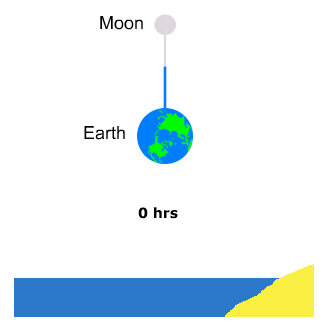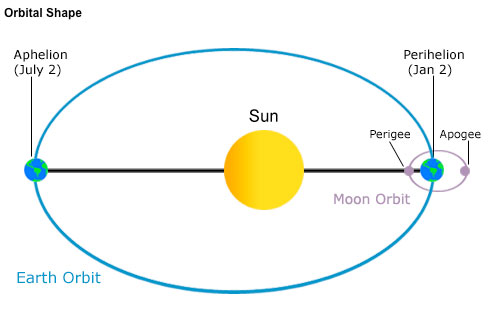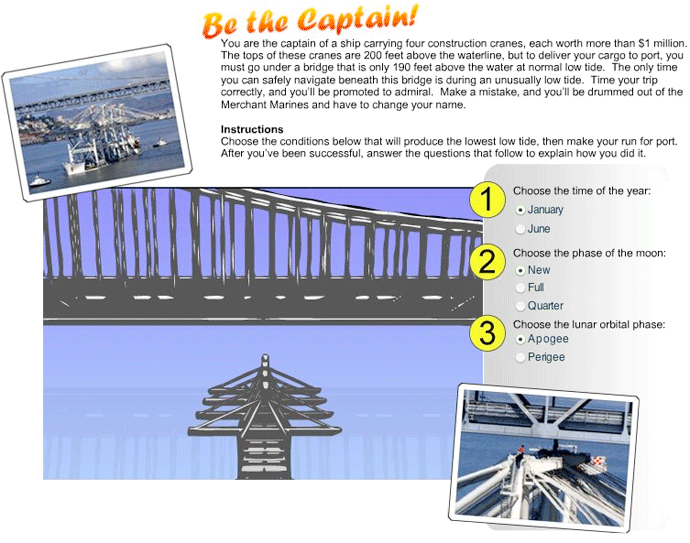Predicting the Tides
Knowing when and how much the tides will rise and fall each day is important to beachcombers, mariners, fishermen, and the people who operate seaside industrial and commercial facilities. Miscalculating the arrival and size of the tides can have expensive, even deadly, consequences.
Predicting the tides is complicated because the tides are affected by many factors. In this activity, you’ll have a chance to consider some of the most important and universal influences, those due to the movements of the sun, the moon, and the earth. In reality, a number of local and transient factors, such as the shape of the coastline, the flow of currents, and the weather, must also be taken into account.
Instructions: Observe the relationship between the lunar day and the time, then answer the questions below.

Over the course of what is called a lunar day, a spot on earth that is directly beneath the moon rotates once until the moon is again exactly overhead. Because the earth spins in the same direction that the moon orbits the planet, the cycle is slightly longer than a regular day -- it takes 24 hours and 50 minutes.
- How much time passes between one high tide and the next?
[Check Answer]
The tides are caused mainly by the gravitational attraction between the moon and the earth, so the spacing between tides will depend on the length of the lunar day. Since the lunar day is 24 hours and 50 minutes long and the earth rotates through two tidal bulges in that time, high tides will be spaced 12 hours and 25 minutes apart.
- How much time passes between low tide and the next high tide?
[Check Answer]
High tides are 12 hours and 25 minutes apart and are separated by a low tide. So low tide must come 6 hours and 12.5 minutes after one high tide and before the next.
Position of the Sun and Moon

The height of the tides varies over the course of a month. The highest highs and lowest lows, called spring tides, occur when the moon and the sun are aligned. Moderate highs and lows, called neap tides, happen when the sun and the moon are at 90° to one another.
- Explain how spring and neap tides are created.
[Check Answer]
The tides are created by the pull of the moon and the sun. When those bodies are aligned with one another, their gravitational forces act in the same direction and reinforce one another, creating the maximum possible tidal bulges, called the spring tides. When the sun and moon are at 90o from one another, relative to Earth, their tidal forces are also pulling in different directions, so the neap tides are minimized.
- How many spring and neap tides occur each month? Why?
[Check Answer]
There are 2 spring and 2 neap tides each month. The moon rotates around the earth once in a month, so in that time it will be aligned with the sun twice, and at 90° to the sun twice.
Orbital Shape

- Why does the distance from the earth to the moon or the sun affect the tides?
[Check Answer]
The tide generating force depends on the mass of an object and its distance. As the distance between the earth and the moon or sun changes, the tidal force each produces will vary.
- When will lunar tides be higher, at perigee or apogee? How often does each occur?
[Check Answer]
The lunar tides will be highest when the moon is closest to the earth, a point in the moon’s orbit that is called perigee. It takes the moon a month to complete an orbit, so perigee will happen about once a month.
- When will solar tides be higher, at perihelion or aphelion? How often does each occur?
[Check Answer]
The solar tides will be highest when the sun is closest to the earth, a point in the earth’s orbit that is called perihelion. It takes the earth a year to complete an orbit around the sun, so perihelion will happen once a year.
Be the Captain
Click the image above to test different scenarios of time of year, moon phase, and orbital phase, to see which tidal levels permit safe travel. Then answer the following questions:
- Describe the conditions that made a safe trip possible.
[Check Answer]
Tidal ranges are greatest (higher high and lower lows) when the gravitational forces of the sun and moon are at their maximum and working in the same direction. This will happen when the sun is at its closest point to earth (during perihelion in early January) and so is the moon (at perigee), and when the two are in a line with Earth (during the full and new moons).
- Your sister ship will have to wait to make the same attempt until you unload your cargo and clear the dock. If you leave on a high tide that crests at noon, when should your fellow captain make his move?
[Check Answer]
If the dock becomes clear at noon, the subsequent low tide will follow 6 hours and 12.5 minutes later. So the other captain should try to pass under the bridge just after 6 p.m.
Related Links
Multimedia Discovery Missions: Lesson 10 - Tides


